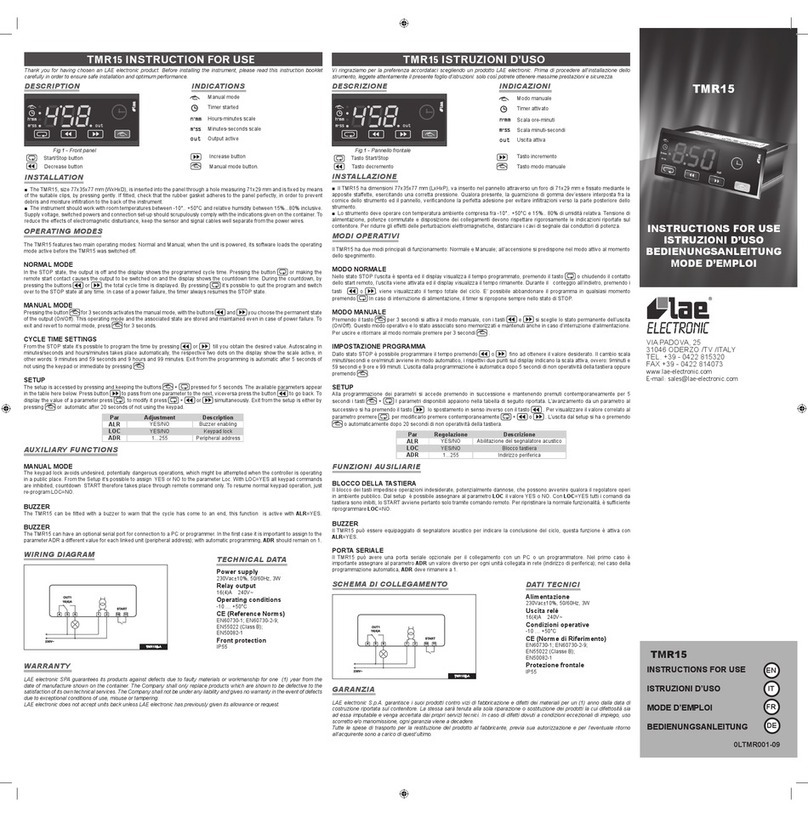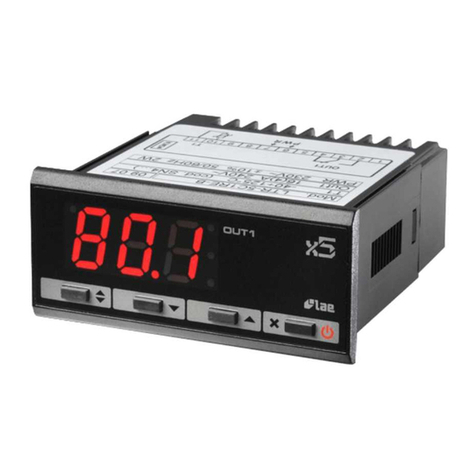the fans will be stopped and will only re-start after defrost, when the conditions in paragraph 6.4 have been met.
6.4 After defrosting, if probe T2 is active (T2=YES), temperature FDD provides evaporator fan re-start. So the evaporator fans will
remain off until the evaporator has a temperature higher than FDD. If such condition doesn’t occur within 4 minutes following defrost
termination, the fans will however be switched on again.
* The way the fans will be controlled depends on the selection I/II: in mode Ithey work according to FTC, while in mode II the fans
work according to IIFT.
7. ALARMS
With MP1-15, correct operation of the thermostat may be monitored by a wide range of functional and diagnostics alarms, individually
selectable by means of the relevant parameters. The alarm warnings are given on the display through explicit indications (see following
par.), and intermittent buzzer sounding. During an alarm, by pressing any button, the buzzer is muted. Then, if the alarm persists, the
buzzer will be periodically switched on for 20 seconds every 60 minutes, until the alarm ends (the display indications remain on all the
time). The repeated acoustic warning applies to all alarms with the exception of the condenser cleaning alarm. Operation of the various
elements is given in detail below.
7.1 The parameter ATL establishes the alarm differential for temperatures below set point, ATH the alarm differential for temperatures
above set point. Putting one or both differentials to 0 cuts out the corresponding alarm.
Example 1: C-H=REF, SP= -20, HYS= 2.0, ATL= -5.0, ATH= 05.0; the alarm thresholds are set at –25°(-20-5) and –13° (-20+2+5).
Example 2: C-H=HEA, SP=75, HYS=3, ATL=-10, ATH=7; the alarm threshold are set at +62° (75-3-10) and +82° (75+7).
The alarm warning may be immediate or delayed by the time ATD whenever this is greater than 0. The indication for high temperature
and for low temperature alarm blinks on the display. The alarm indication remains stored in the display, even when the alarm is over,
until you acknowledge the alarm manually by pressing any button.
The high temperature alarm is bypassed during defrosting.
7.2 If a suitable door switch has been connected to detect the door status and door switch input control has been enabled (DS=YES),
the door open alarm function is enabled. In this way, if the door remains open the controller will react after the time delay set with ADO
by displaying the alarm source through the indication .
7.3 Assigning a value greater than 0 to the parameter ACC enables the indication for periodic cleaning of the condenser. Subsequently,
when the count of compressor hours of operation reaches the equivalent in weeks set with ACC, an indication for cleaning appears on
the display.
Example: with ACC=16 there is a warning once every 16x7(weeks)x24(hours)=2688 hours of compressor operation, so, assuming
for this an operation with 5 minutes On and 5 minutes Off - after approx. 32 weeks.
In order to clear the time counter, follow the prescribed procedure in paragraph 2.3.
7.4 Upon failure of probe T1 or, if enabled, probe T2, probe failure is signalled with the blinking indication or respectively.
8. TEMPERATURE STORAGE
The MP1-15 features a system for permanent storage of the minimum and maximum temperature logged during operation. This system
is a valid help to achieve compliance with the HACCP directive in its part relating to a correct preservation of foodstuffs. Temperature is
measured by probe T1 which should therefore be placed in a point where the temperature of the preserved product may always be
measured correctly. The logging is however subject to some simple rules that filter the data and give a rational interpretation. The logging
is suspended during the periods in which the refrigerator is put on a standby and during defrostings and, during the normal operation
(thermostatic control), it’s “slowed down” through the parameter TLD. This parameter defines the time during which the measured
temperature must permanently exceed the current value before the logging is performed. In this way, it will be possible to avoid idle
loggings that don’t reflect the actual product temperature, for example, the door being left open, the temperature recovery after a defrost
or other temporary short term temperature huntings.
It is suggested that a reasonably long TLD time is programmed, for instance 5-15 minutes, you then put the product into the refrigerator
and start a new logging cycle by clearing previous values (see par. 2.3). It will now suffice that at regular intervals, in the INFO menu
you check the minimum and maximum logged values in order to know if the product has been kept within the required temperature limits.
9. AUXILIARY FUNCTIONS
9.1 In addition to the basic functions described above, The MP1-15 offers an innovative feature to enhance the performance of the
refrigerator. In fact, you can select the control parameters between two different pre-programmed groups, in order for the fundamental
control parameters to be adapted quickly to changing needs such as, for example: High/Low Temperature range change, stored product
change (meat, fish, vegetables …), maximum cooling capacity or energy saving. The parameters switched over in mode Iand II are:
SPL, SPH, SP, HYS, DFR, FTC and IISL, IISH, IISP, IIHY, IIDF, IIFT.
With the parameter IISM you select if the changeover from Group Ito Group II is made manually, via the button (IISM=MAN), or

























